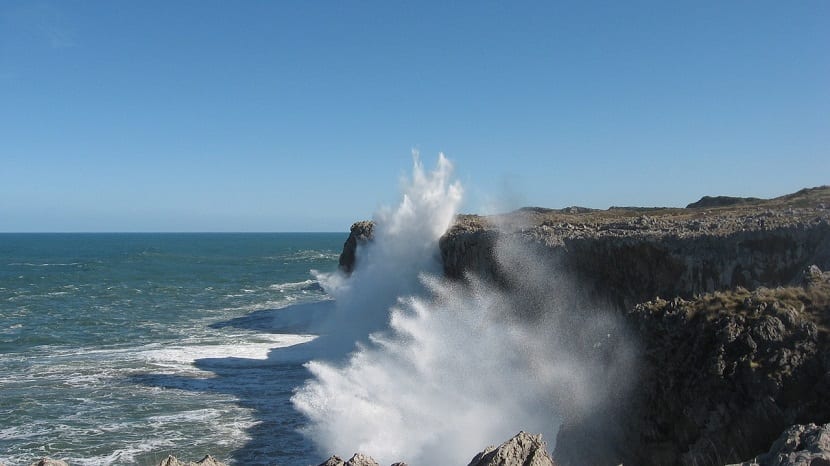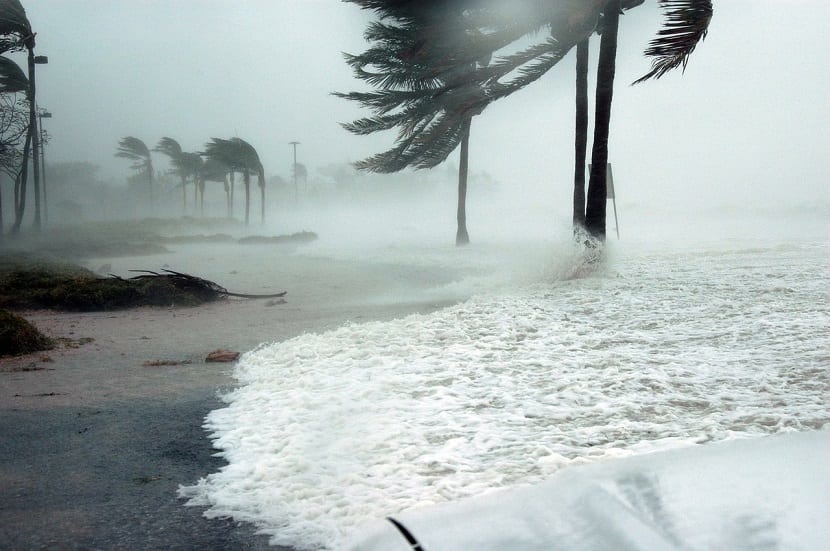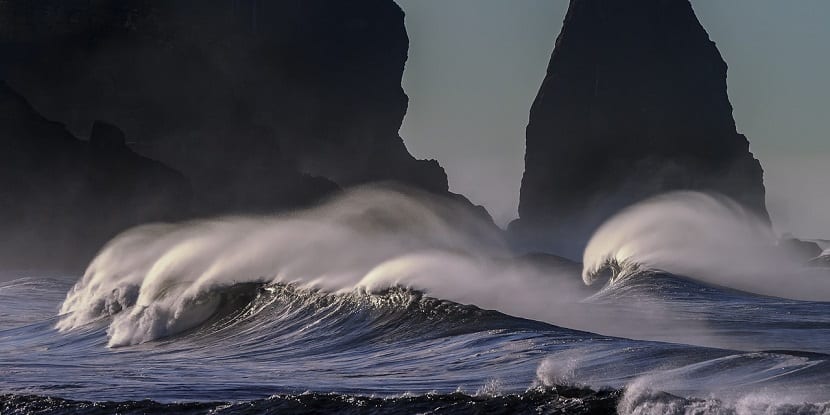
The Beaufort scale, also called, Beaufort scale of force of winds, is an empirical scale. It is related to the state of the sea, regarding the height of its waves and the strength of the wind. The reason that it is empirical, from experience, is that at first it did not count on the speeds of the winds. Rather, it detailed on a scale of 0 to 12. The scale was proportionally related to the difficulties of the ship, although it currently has other uses. The lower the value, the less difficulty in navigating maneuvering. And the higher, the more complicated it gets.
Its name derives from its inventor, Sir Francis Beaufort. He was an Irish naval officer and hydrographer. Before the year 1800, when naval officers made observations about weather and swell, it turned out to be somewhat subjective. As there was no objective scale with which to measure the intensity of the sea state, it was then that Beaufort came up with this scale, and be able to specify and standardize the force with which it should be measured the state of the sea.
History of the Beaufort scale
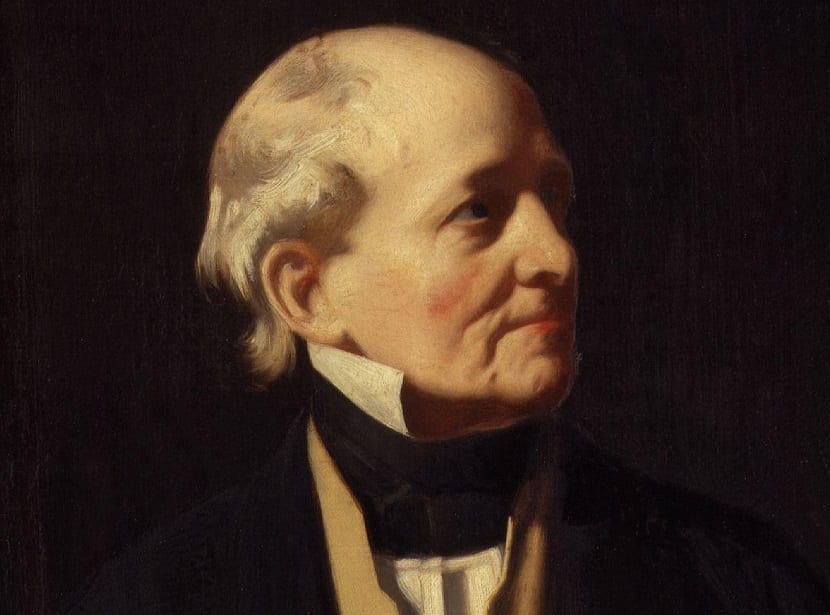
As we have commented, its origins date back to the early nineteenth century. It was not until late 1830s than the Beaufort scale became a standard scale for ship logs of the British Navy.
Something that made the scale and that distinguished it so as not to fall into subjectivities was the representation of each one. Each number in it represented the qualitative conditions of how a ship would cope in each of them.
Starting in 1850, it was adapted for not only naval use. Together with the rotations of an anemometer to measure the wind speed, these measurements were transferred with respect to what was described on the scale. In 1906, the meteorologist George Simpson, I also added descriptions for its effects on the ground. It was favored in a way with the arrival of steam engines.
It was completely standardized in 1923. Decades later it underwent some modification, such as the integration of hurricanes according to their intensity from 12 to 16. A hurricane of category 1, on the Beaufort scale corresponds to 12, of category 2 is 13 on the Beaufort scale, and so on. successively.
The order of scale and its effects on land and sea
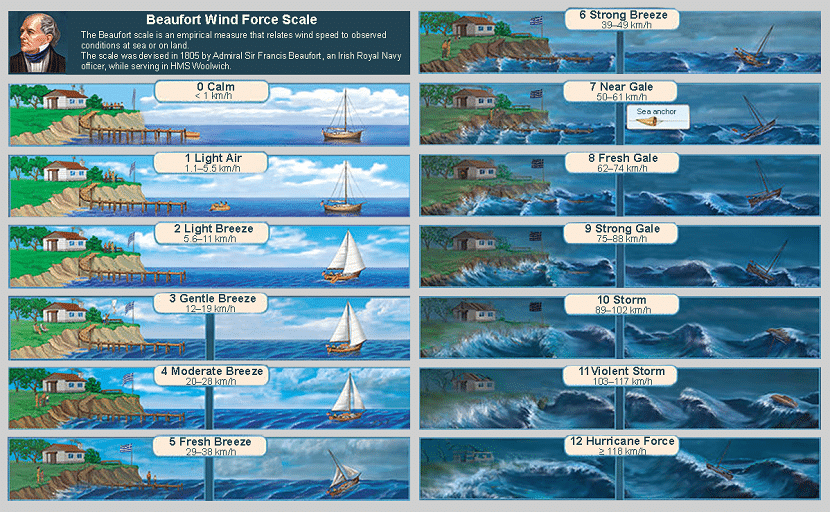
Drawing representation of the effects of each number on the scale
Then the order from lowest to highest degree, up to number 12, because from there we start talking about hurricanes. Wind speed is represented in km / h, and nautical knots in nautical miles / h.
| Scale | Force | Wind speed | Knots | Appearance of the sea | Effects on Earth |
|---|---|---|---|---|---|
| 0 | Calm | 0 to 1 | less than 1 | Calmed down | Total calm, no tree leaves move, smoke rises vertically |
| 1 | Light air (wind) | 2 to 5 | 1 to 3 | Small waves, no foam is generated | slight movement of leaves, smoke indicates the direction of the wind |
| 2 | Light Breeze (weak) | 6 to 11 | 4 to 6 | wave crests a little higher, but without breaking | Tree leaves may fall, the mills in the fields begin to move |
| 3 | Gentle breeze (loose) | 12 to 19 | 7 to 10 | Small waves and ridges that are already breaking | Leaves fluttering, flags wave |
| 4 | Moderate breeze (mild) | 12 to 19 | 11 to 16 | longer waves with ridges, numerous lambs | flags fully extended. Gentle movement of tree branches and shaking of their tops |
| 5 | Moderate breeze (cool) | 29 to 38 | 17 to 21 | Medium and moderate long waves. Sheep very abundant | The surface of the lakes ripples, small movements of the trees. Flags outstretched and shaking |
| 6 | Strong breeze (cool) | 39 to 49 | 22 to 27 | Large waves begin to form, with breaking crests and foam | more abrupt movements of tree branches. We may find it difficult to keep the umbrella open |
| 7 | Strong wind (fresh) | 50 to 61 | 28 to 33 | Heavy sea, choppy, with foam carried in the direction of the wind | Large trees sway and tilt, difficulty walking against the wind |
| 8 | Hard wind (temporary) | 62 to 74 | 34 to 40 | Big breaking waves, foam on the surface | Branches and treetops are broken, walking is very difficult, lighter vehicles can move by themselves |
| 9 | Very hard wind (strong storm) | 75 to 88 | 41 to 47 | Very large and breaking waves, difficult to visualize | Tree branches break off them, weak building roofs can break off. Vehicles can be dragged and it is impossible to walk normally |
| 10 | Temporary hard (temporary) | 89 to 102 | 48 to 55 | The surface of the sea is already white. The swell is very thick. | Trees uprooted, damage to building structures, and extensive damage to things that are out in the open. |
| 11 | Very hard storm (Squall) | 103 to 117 | 56 to 63 | Exceptionally large waves, completely white sea, almost zero visibility | Damage everywhere, very heavy rains, big floods. People and many other objects can be blown away by the wind. |
| 12 | Hurricane storm (Hurricane) | +118 | +64 | Exceptionally gigantic waves, completely zero visibility. | People can get blown up, vehicles, trees, weaker houses, roofs. |
(From the number 12 a hurricane or typhoon can originate, the scale would continue with the categories of hurricanes. Although it has been mixed with the Beaufort scale, they would belong to another denomination. The Beaufort scale was conceived above all to be able to describe the state of the sea for ships)

